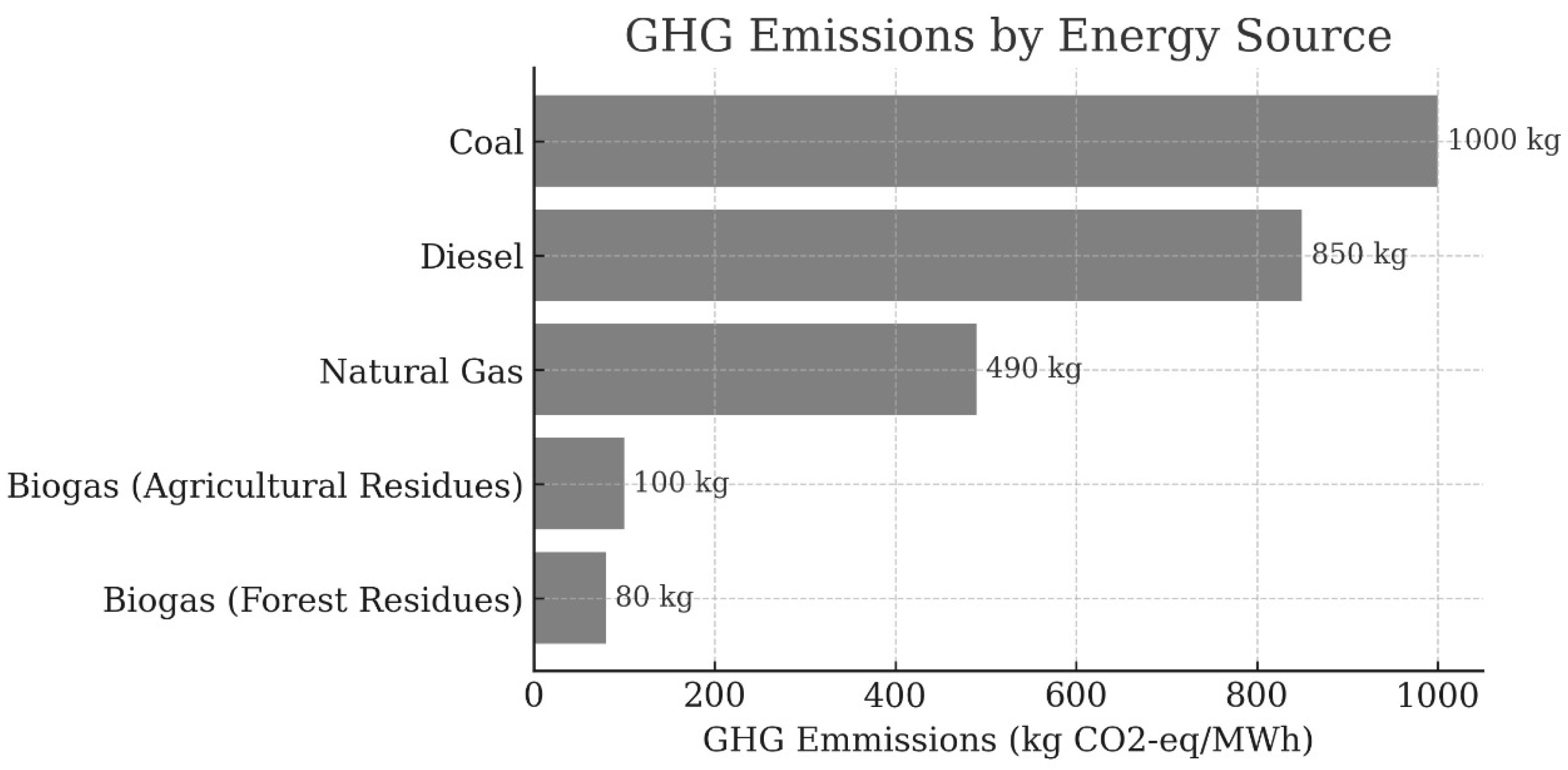Biogas Production from Organic Waste in the Forestry and Agricultural Context: Challenges and Solutions for a Sustainable Future
Abstract
1. Introduction
2. Technical Fundamentals of Biogas
Integrated Optimization and Emerging Technologies
3. Bioenergy Potential and Classification of Agricultural and Forestry Waste
3.1. Forest Waste
3.2. Agricultural Waste
3.3. Biogas Potential at a Global Level
4. Environmental Impacts, Socioeconomic Opportunities, and Implementation Frameworks
4.1. Technological Opportunities: Accessibility, Scalability, and Maintenance
4.2. Economics: Initial Investment, Profitability, and Subsidies
4.3. Policies: Regulatory Framework, Incentives, and Certifications
4.4. Social Opportunities: Acceptance, Technical Knowledge, and Training
4.5. Global Route for Biogas Implementation
5. A Global and Transdisciplinary Approach to the Challenges, Knowledge, and Future Prospects of Biogas Production from Agricultural and Forestry Waste
5.1. Knowledge Gaps
5.1.1. Current Critical Challenges
5.1.2. Future Lines of Research
6. Conclusions
Author Contributions
Funding
Data Availability Statement
Conflicts of Interest
Abbreviations
| CO2 | carbon dioxide |
| CH4 | methane |
| GHG | greenhouse gas |
| VFA | volatile fatty acid |
| UASB | upflow anaerobic sludge blanket |
| CSTR | continuously stirred tank reactor |
| GWh | gigawatt-hour |
| TWh | terawatt-hour |
| MW | megawatt |
| PJ/EJ | petajoule/exajoule |
| MJ/kg | megajoules per kilogram |
| Mt | million tons |
| MWh | megawatt-hour |
References
- UN-Habitat. United Nations Human Settlements Programme 2023. International Zero Waste Day. 2023. Available online: https://onu-habitat.org/index.php/dia-internacional-de-cero-desechos (accessed on 6 February 2025).
- UNEP. Global Waste Management Outlook 2024: Beyond an Age of Waste—Turning Rubbish into a Resource; UNEP: Nairobi, Kenya, 2024; ISBN 978-92-807-4129-2. [Google Scholar] [CrossRef]
- ROYAL SPANISH ACADEMY. Dictionary of the Spanish Language, Biogas 23rd Ed., 2024. [Online Version 23.8]. Available online: https://dle.rae.es (accessed on 5 February 2025).
- WBA. How Can Biogas Help Mitigate Climate Change? 2018. Available online: https://www.worldbiogasassociation.org/wp-content/uploads/2018/07/WBA-Climate-Change-Biogas-factsheet-2.pdf (accessed on 5 February 2025).
- FAO. Food Wastage Footprint Impacts on Natural Resources. Summary Report. 2023. Available online: https://www.fao.org/4/i3347e/i3347e.pdf (accessed on 5 February 2025).
- FAO. Global Food Losses and Waste. Extent, Causes and Prevention. 2011. Available online: http://www.fao.org/docrep/014/mb060e/mb060e00.pdf (accessed on 5 February 2025).
- International Energy Agency. Outlook for Biogas and Biomethane: Prospects for Organic Growth. IEA 2020. Available online: https://www.iea.org/reports/outlook-for-biogas-and-biomethane-prospects-for-organic-growth (accessed on 6 February 2025).
- Wang, Z.; Sanusi, I.A.; Wang, J.; Ye, X.; Kana, E.B.G.; Olaniran, A.O.; Shao, H. Developments and Prospects of Farmland Application of Biogas Slurry in China—A Review. Microorganisms 2023, 11, 2675. [Google Scholar] [CrossRef] [PubMed]
- European Commission. Transforming Organic Waste into Fertiliser for Emissions-Free Agriculture and Forestry. 2020. CORDIS. Available online: https://cordis.europa.eu/article/id/421818-transforming-organic-waste-into-fertiliser-for-emissions-free-agriculture-and-forestry (accessed on 10 February 2025).
- Velásquez-Piñas, J.A.; Calle-Roalcaba, O.D.; Miramontes-Martínez, L.R.; Alonso-Gómez, L.A. Economic and environmental assessment of biogas utilization technologies and perspectives of multicriteria analysis. ION J. 2023, 36, 29–47. [Google Scholar] [CrossRef]
- Cervi, R.G.; Esperancini, M.S.; Bueno, O.D.C. Economic Viability of using Biogas for Electrical Power Generation. Inf. Technol. 2011, 22, 3–14. [Google Scholar] [CrossRef]
- U.S. Energy Information Administration. Landfill Gas and Biogas. 2023. Available online: https://www.eia.gov/energyexplained/biomass/landfill-gas-and-biogas.php (accessed on 11 February 2025).
- U.S. Department of Agriculture. Biogas Opportunities Roadmap. 2014. Available online: https://www.usda.gov/sites/default/files/documents/Biogas_Opportunities_Roadmap_8-1-14.pdf (accessed on 11 February 2025).
- MINENERGIA/UNDP/FAO/GEF, Ministry of Energy, United Nations Development Programme, Food and Agriculture Organization of the United Nations, Global Environment Facility. Biogas Manual. Project CHI/00/G32 “Chile: Removing Barriers to Rural Electrification with Renewable Energy”. 2011. Available online: https://www.fao.org/4/as400s/as400s.pdf (accessed on 10 February 2025).
- U.S. Environmental Protection Agency. Frequent Questions About Anaerobic Digestion. 2023. Available online: https://www.epa.gov/anaerobic-digestion/frequent-questions-about-anaerobic-digestion (accessed on 10 February 2025).
- Parra Huertas, R.A. Digestión anaeróbica: Mecanismos biotecnológicos en el tratamiento de aguas residuales y su aplicación en la industria alimentaria. Prod. + Limpia 2015, 10, 142–159. [Google Scholar] [CrossRef]
- Acosta, Y.L.; Obaya Abreu, M.C. Anaerobic digestion. Theoretical aspects. Part I. ICIDCA Sugarcane Deriv. 2005, 39, 35–48. [Google Scholar]
- Government of Santa Fe. Unit II. Operation and Maintenance of Biodigesters. Secretary of State for Energy, Undersecretary of Renewable Energy. Available online: https://www.santafe.gob.ar/ms/academia/wp-content/uploads/sites/27/2019/08/M%C3%B3dulo-2-Biodigesti%C3%B3n-anaer%C3%B3bica.pdf (accessed on 15 February 2025).
- García-Elías, O.; Marín-Peña, O.; Alvarado-Lassman, A.; Vallejo-Cantú, N.A.; Rosas-Mendoza, E.S. Effect of hydrolysis on two-stage anaerobic digestion of fruit and vegetable waste. Rinderesu 2020, 5, 463–471. [Google Scholar]
- Bennardi, D.O. Anaerobic Digestion: Biogas Production. FCAyF Virtual Classroom. 2021. National University of La Plata. Available online: https://aulavirtual.agro.unlp.edu.ar/pluginfile.php/126426/mod_resource/content/1/Apunte%20sobre%20digesti%C3%B3n%20anaer%C3%B3bica%20y%20biog%C3%A1s%20_Edici%C3%B3n%202021_.pdf (accessed on 16 February 2025).
- Oh, S.; Lee, J.; Lam, S.S.; Kwon, E.E.; Ha, J.M.; Tsang, D.C.; Ok, Y.S.; Chen, W.H.; Park, Y.K. Fast hydropyrolysis of biomass Conversion: A comparative review. Bioresour. Technol. 2021, 342, 126067. [Google Scholar] [CrossRef]
- Appels, L.; Baeyens, J.; Degrève, J.; Dewil, R. Principles and potential of the anaerobic digestion of waste-activated sludge. Prog. Energy Combust. Sci. 2008, 34, 755–781. [Google Scholar] [CrossRef]
- Singh, K.; Ainala, S.K.; Park, S. Metabolic engineering of Lactobacillus reuteri DSM 20,016 for improved 1,3-propanediol production from glycerol. Bioresour. Technol. 2021, 338, 125590. [Google Scholar] [CrossRef]
- Angelidaki, I.; Treu, L.; Tsapekos, P.; Luo, G.; Campanaro, S.; Wenzel, H.; Kougias, P.G. Biogas upgrading and utilization: Current status and perspectives. Biotechnol. Adv. 2018, 36, 452–466. [Google Scholar] [CrossRef]
- Demirel, B.; Scherer, P. The roles of acetotrophic and hydrogenotrophic methanogens during anaerobic conversion of biomass to methane: A review. Rev. Environ. Sci. Biotechnol. 2008, 7, 173–190. [Google Scholar] [CrossRef]
- Deublein, D.; Steinhauser, A. Biogas from Waste and Renewable Sources: An Introduction; Wiley-VCH: Hoboken, NJ, USA; Verlag GmbH & Co. KGaA: Weinheim, Germany, 2008. [Google Scholar] [CrossRef]
- Mao, C.; Feng, Y.; Wang, X.; Ren, G. Review on research achievements of biogas from anaerobic digestion. Renew. Sustain. Energy Rev. 2015, 45, 540–555. [Google Scholar] [CrossRef]
- Schink, B. Energetics of syntrophic cooperations in methanogenic degradation. Microbiol. Molec. Biol. Rev. 1997, 61, 262–280. [Google Scholar]
- Stams, A.; Plugge, C. Electron transfer in syntrophic communities of anaerobic bacteria and archaea. Nat. Rev. Microbiol. 2009, 7, 568–577. [Google Scholar] [CrossRef] [PubMed]
- McInerney, M.J.; Struchtemeyer, C.G.; Sieber, J.; Mouttaki, H.; Stams, A.J.M.; Schink, B.; Rohlin, L.; Gunsalus, R.P. Physiology, Ecology, Phylogeny, and Genomics of Microorganisms Capable of Syntrophic Metabolism. Ann. N. Y. Acad. Sci. 2008, 1125, 58–72. [Google Scholar] [CrossRef]
- Guerrero-Toledo, F.D.M.; Espinosa-Solares, T.; Balagurusamy, N.; Guerra-Ramírez, D.; Huber, D.H.; Hernández-Eugenio, G. Potencial bioquímico de metano de pollinaza adicionada con propionato en condiciones mesofílicas. Sci. Agropecu. 2019, 10, 307–311. [Google Scholar] [CrossRef]
- Thauer, R.K.; Kaster, A.K.; Seedorf, H.; Buckel, W.; Hedderich, R. Methanogenic archaea: Ecologically relevant differences in energy conservation. Nat. Rev. Microbiol. 2008, 6, 579–591. [Google Scholar] [CrossRef] [PubMed]
- Lovley, D.R. Syntrophy goes electric: Direct interspecies electron transfer. Annu. Rev. Microbiol. 2017, 71, 643–664. [Google Scholar] [CrossRef]
- Sawatdeenarunat, C.; Surendra, K.C.; Takara, D.; Oechsner, H.; Khanal, S.K. Anaerobic digestion of lignocellulosic biomass: Challenges and opportunities. Bioresour. Technol. 2015, 178, 178–186. [Google Scholar] [CrossRef]
- Juneja, A.; Kumar, D.; Rajendran, K.; Mittal, A. Chapter 4-Pretreatment Technologies for Lignocellulosic Biomass Refineries. In Advances in Lignocellulosic Biofuel Production Systems: Applied Biotechnology Reviews Series; Moodley, P., Ray, R.C., Kana, E.B.G., Eds.; Woodhead Publishing: Sawtons, UK, 2023; pp. 81–106. [Google Scholar] [CrossRef]
- Fan, J.; Lu, Y.; An, N.; Zhu, W.; Li, M.; Gao, M.; Wang, X.; Wu, C.; Wang, Y. Pretreatment technologies for lignocellulosic biomass: Research progress, mechanisms, and prospects. BioResources 2025, 20, 4897–4924. [Google Scholar] [CrossRef]
- Rozzi, E.; Gandiglio, M.; Lanzini, A.; Santarelli, M. Adsorption model for biogas purification: A design tool for solid oxide fuel cells application. J. Clean. Prod. 2025, 503, 145382. [Google Scholar] [CrossRef]
- Zabed, H.M.; Akter, S.; Yun, J.; Zhang, G.; Zhao, M.; Mofijur, M.; Awasthi, M.K.; Kalam, M.A.; Ragauskas, A.; Qi, X. Towards the sustainable conversion of corn stover into bioenergy and bioproducts through biochemical route: Technical, economic and strategic perspectives. J. Clean. Prod. 2023, 400, 136699. [Google Scholar] [CrossRef]
- Li, Y.; Ren, Y.; Ji, J.; Li, Y.-Y.; Kobayashi, T. Anaerobic Membrane Bioreactors for Municipal Wastewater Treatment, Sewage Sludge Digestion and Biogas Upgrading: A Review. Sustainability 2023, 15, 15129. [Google Scholar] [CrossRef]
- Zainal, A.; Harun, R.; Idrus, S. Performance Monitoring of Anaerobic Digestion at Various Organic Loading Rates of Commercial Malaysian Food Waste. Front. Bioeng. Biotechnol. 2022, 10, 775676. [Google Scholar] [CrossRef]
- Wang, Z.; Wang, T.; Si, B.; Watson, J.; Zhang, Y. Accelerating anaerobic digestion for methane production: Potential role of direct interspecies electron transfer. Renew. Sustain. Energy Rev. 2021, 145, 111069. [Google Scholar] [CrossRef]
- Harirchi, S.; Wainaina, S.; Sar, T.; Nojoumi, S.A.; Parchami, M.; Parchami, M.; Varjani, S.; Khanal, S.K.; Wong, J.; Awasthi, M.K.; et al. Microbiological insights into anaerobic digestion for biogas, hydrogen or volatile fatty acids (VFAs): A review. Bioengineered 2022, 13, 6521–6557. [Google Scholar] [CrossRef]
- De Jonge, N. Microbial Community Dynamics in Anaerobic Digestion; Aalborg Universitetsforlag: Aalborg, Denmark, 2017; Volume 49. [Google Scholar] [CrossRef]
- Ostos, I.; Flórez-Pardo, L.M.; Camargo, C. A metagenomic approach to demystify the anaerobic digestion black box and achieve higher biogas yield: A review. Front. Microbiol. 2024, 15, 1437098. [Google Scholar] [CrossRef]
- Fernando Herrera Adarme, O.; Eduardo Lobo Baêta, B.; Cardoso Torres, M.; Camilo Otalora Tapiero, F.; Vinicius Alves Gurgel, L.; de Queiroz Silva, S.; Francisco de Aquino, S. Biogas production by anaerobic co-digestion of sugarcane biorefinery byproducts: Comparative analyses of performance and microbial community in novel single-and two-stage systems. Bioresour. Technol. 2022, 354, 127185. [Google Scholar] [CrossRef]
- Burboa Charis, V.A.; Orrantia López, M.; Álvarez Valencia, L.H. Electron-conducting materials and their impact during anaerobic digestion for methane production. Entreciencias Diálogos Soc. Conoc. 2023, 11, e2585046. [Google Scholar] [CrossRef]
- Devi, P.; Eskicioglu, C. Effects of biochar on anaerobic digestion: A review. Env. Chem Lett. 2024, 22, 2845–2886. [Google Scholar] [CrossRef]
- Su, K.; Li, L.; Wang, Q.; Cao, R. A Review on the Interspecies Electron Transfer of Methane Production in Anaerobic Digestion System. Fermentation 2023, 9, 467. [Google Scholar] [CrossRef]
- Zhang, S.; Pan, G.; Li, B.; Gu, W.; Fu, J.; Sun, Y. Multi-Timescale Security Evaluation and Regulation of Integrated Electricity and Heating System. IEEE Trans. Smart Grid. 2024, 16, 1088–1099. [Google Scholar] [CrossRef]
- Fajrina, N.; Yusof, N.; Fauzi Ismail, A.; Aziz, F.; Roil Bilad, M.; Alkahtani, M. A crucial review on the challenges and recent gas membrane development for biogas upgrading. J. Environ. Chem. Eng. 2023, 11, 110235. [Google Scholar] [CrossRef]
- Aghel, B.; Behaein, S.; Wongwises, S.; Shadloo, M.S. A review of recent progress in biogas upgrading: With emphasis on carbon capture. Biomass Bioenergy 2022, 160, 106422. [Google Scholar] [CrossRef]
- IEA. Renewables 2024 Analysis and Forecast to 2030. 2024. Available online: https://www.iea.org/reports/renewables-2024 (accessed on 23 May 2025).
- Li, W.; Zou, Y.; Yang, H.; Fu, X.; Xiang, S.; Li, Z. Two-Stage Stochastic Energy Scheduling for Multi-Energy Rural Microgrids with Irrigation Systems and Biomass Fermentation. IEEE Trans. Smart Grid 2025, 16, 1075–1087. [Google Scholar] [CrossRef]
- Bioenergy Europe. Biogas Statistical Report 2022. Available online: https://bioenergyeurope.org/statistical-reports/ (accessed on 23 May 2025).
- Hassanein, A.; Lansing, S. Delp. Anaerobic Digestion (EBR-20230686). 2024. University of Maryland Extension. go.umd.edu/EBR-2023-0686. Available online: https://extension.umd.edu/sites/extension.umd.edu/files/publications/AnaerobicDigestion_EBR-2023-0686-ada.pdf (accessed on 23 May 2025).
- Mignogna, D.; Ceci, P.; Cafaro, C.; Corazzi, G.; Avino, P. Producción de biogás y biometano como fuentes de energía renovable: Una revisión. Cienc. Aplicadas. 2023, 13, 10219. [Google Scholar] [CrossRef]
- Yánez-Iñiguez, L.; Urgilés-Urgilés, E.; Zalamea-León, E.; Barragán-Escandón, A. Potencial de los Residuos Forestales para la contribución a la Matriz Energética Urbana. La Granja. Rev. Cienc. Vida 2020, 32, 42–53. [Google Scholar] [CrossRef]
- Ayala-Mendivil, N.; Sandoval, G. Bioenergía a partir de residuos forestales y de madera. Madera Y Bosques 2018, 24, e2401877. [Google Scholar] [CrossRef]
- Villela-Suárez, J.M.; Aguirre-Calderón, O.A.; Treviño-Garza, E.J.; Vargas-Larreta, B. Availability of forest residues and their potential for energy generation in the temperate forests of El Salto, Durango. Madera Y Bosque 2018, 24, e2431529. [Google Scholar] [CrossRef]
- López Villacis, I.C.; Santana, R.C.; Artieda, J.R.; Vásquez, C.L. Evaluación del potencial energético de biomasa residual agrícola como recurso energético renovable en Tungurahua, Ecuador. Rev. Boliv. Química 2024, 41, 14–23. [Google Scholar] [CrossRef]
- Velasco Morales, M.A.; Venegas-Venegas, J.A.; Reyes Sosa, M.B.; Hernández-Altemirano, R.; Mena-Cervantes, V.Y.; Pinto Ruíz, R.; López de Paz, P.; Meza Avendaño, C.A.; Aguilar-Aguilar, F.A. Sustainable biogas production by anaerobic co-digestion of whey and bovine manure. Biotecnia 2024, 26, e2063. [Google Scholar] [CrossRef]
- Domínguez-Villanueva, J.E.; Acázar-Medina, F.A.; Rodríguez-Rosales, M.D.J.; De la Peña-Arellano, L.A.; Valencia-Vázquez, R. Anaerobic co-digestion of wastewater sludge and pig manure to enhance biogas production. Rev. Int. Desarro. Reg. Sustentable 2020, 5, 734–747. Available online: https://rinderesu.com/index.php/rinderesu/article/view/89 (accessed on 27 May 2025).
- EEAOC. 2023. Available online: https://www.eeaoc.gob.ar/wp-content/uploads/2023/07/Estado-de-situacion-y-potencial-de-produccion-de-biogas.pdf (accessed on 27 May 2025).
- Montenegro Orozco, K.T.; Rojas Carpio, A.S.; Cabeza Rojas, I.; Hernández Pardo, M.A. Biogas potential of agroindustrial waste generated in the department of Cundinamarca. ION J. 2016, 29, 23–37. [Google Scholar] [CrossRef]
- Barreña, M.; Knoll, P. Agricultural waste-to-energy transformation: Current status and potential in Argentina. RIVAR 2023, 10, 160–190. [Google Scholar] [CrossRef]
- Chamy, R.; Vivanco, E. Potencial de Biogas. Identificación y Clasificación de los Distintos Tipos de Biomasa Disponibles en Chile Para la Generación de Biogás, 1st ed.; Proyecto Energías Renovables No Convencionales en Chile (CNE/GTZ): Santiago de Chile, Chile, 2007; pp. 1–82. [Google Scholar]
- Ministry for Ecological Transition and the Demographic Challenge. 2023. Available online: https://www.miteco.gob.es/es/ministerio/planes-estrategias/plan-nacional-integrado-energia-clima/ (accessed on 20 February 2025).
- Haberl, H.; Erb, K.H.; Krausmann, F.; Bondeau, A.; Lauk, C.; Müller, C.; Plutzar, C.; Steinberger, J.K. Global bioenergy potentials from agricultural land in 2050: Sensitivity to climate change, diets and yields. Biomass Bioenergy 2011, 35, 4753–4769. [Google Scholar] [CrossRef]
- STOA. 2013. Available online: https://www.europarl.europa.eu/RegData/etudes/etudes/join/2013/513513/IPOL-JOIN_ET(2013)513513_EN.pdf (accessed on 26 February 2025).
- IEA-Bioenergy. 2021. Available online: https://www.ieabioenergy.com/wp-content/uploads/2021/10/IEA-Bioenergy-SDG-Case-Study-Report-FINAL-1.pdf (accessed on 28 February 2025).
- Tolessa, A. Bioenergy potential from crop residue biomass resources in Ethiopia. Heliyon 2023, 9, e13572. [Google Scholar] [CrossRef] [PubMed]
- WEFORUM. 2024. Available online: https://es.weforum.org/stories/2024/01/como-convertir-los-residuos-de-biomasa-en-combustible-puede-ayudar-a-restablecer-el-equilibrio-de-carbono/ (accessed on 3 March 2025).
- Mouratiadou, I.; Stella, T.; Gaiser, T.; Wicke, B.; Nendel, C.; Ewert, F.; van der Hilst, F. Sustainable intensification of crop residue exploitation for bioenergy: Opportunities and challenges. GCB Bioenergy 2019, 12, 71–89. [Google Scholar] [CrossRef]
- REMBIO. 2011. Available online: https://rembio.org.mx/wp-content/uploads/2023/05/CT4.pdf (accessed on 7 March 2025).
- Sánchez-Pólito, J.E.; Tauro, R.; Argueta-Navarrete, P.I.; Martínez-Bravo, R.; Álvarez-Ayala, M.A.; Masera, O. The Consumption Pattern of Solid Biofuels in Mexico: A Model for Their Comprehensive Analysis. Mexico: 2024 Pronace ecc-Conahcyt. Available online: https://secihti.mx/wp-content/uploads/pronaces/micrositios/energia_y_cambio_climatico/energia/cuadernos_tematicos/Cuaderno_7.pdf (accessed on 12 March 2025).
- SAGARPA. 2017. Available online: https://www.gob.mx/cms/uploads/attachment/file/257070/Potencial-Bioenerg_ticos.pdf (accessed on 15 March 2025).
- Nava-Pacheco, D.; Juárez-García, I.A.; Landeta-Escamilla, O.; Del Moral, S.; Rosas-Mendoza, E.S. Bioenergy potential from agroindustrial waste in the state of Veracruz. Renew. Energy Biomass Sustain. 2019, 1, 53–64. [Google Scholar]
- IRENA (International Renewable Energy Agency). 2021. Available online: https://www.irena.org/-/media/Files/IRENA/Agency/Publication/2021/Nov/IRENA_FAO_Renewables_Agrifood_2021.pdf (accessed on 22 March 2025).
- FAO (Food and Agriculture Organization of the United Nations). 2021. Available online: https://www.fao.org/3/ca9473en/CA9473EN.pdf (accessed on 24 March 2025).
- FAO (Food and Agriculture Organization of the United Nations). 2013. Available online: https://www.fao.org/4/i3388s/i3388s.pdf (accessed on 24 March 2025).
- Venegas-Venegas, J.A.; Pinto-Ruiz, R.; Guevara-Hernández, F.; Pérez-Fernández, A.; Aryal, D.R.; Aguilar-Aguilar, F.A. Biogas potential, electricity, CO2eq reduction and profitability of a biodigester-motor generator for dairy farms in Mexico. Social studies. J. Contemp. Food. Reg. Dev. 2023, 33, e231374. [Google Scholar] [CrossRef]
- Morales, I.G.C.; Gamez, M.R. Biogas production potential for energy use in the rural context of Manabí. Ing. Energética 2022, 43, 62–70. [Google Scholar]
- Uusitalo, V.; Havukainen, J.; Manninen, K.; Höhn, J.; Lehtonen, E.; Rasi, S.; Soukka, R.; Horttanainen, M. Carbon footprint of selected biomass to biogas production chains and GHG reduction potential in transportation use. J. Renew. Energy 2014, 66, 90–98. [Google Scholar] [CrossRef]
- REN21. Renewables 2022 Global Status Report. 2022. Record Growth in Renewables, but World Missed Historic Chance for a Clean Energy Recovery. Available online: https://www.ren21.net/reports/global-status-report/ (accessed on 3 March 2025).
- IRENA. (International Renewable Energy Agency). 2022. Available online: https://www.irena.org/News/articles/2022/Nov/Renewable-Energy-for-Agri-food-Systems (accessed on 3 March 2025).
- Díaz-Arias, A.A. Biogas: An energy source for future generations in the post-oil era. Agroind. Soc. Y Ambiente. 2022, 2, 104–122. [Google Scholar] [CrossRef]
- IEA. 2023. Available online: https://www.iea.org/reports/renewables-2023/special-section-biogas-and-biomethane (accessed on 7 April 2025).
- IEA. 2025. Available online: https://www.iea.org/policies (accessed on 7 April 2025).
- European Commission. 2018. Available online: https://op.europa.eu/en/publication-detail/-/publication/edace3e3-e189-11e8-b690-01aa75ed71a1/language-en (accessed on 7 April 2025).
- Mugodo, K.; Magama, P.P.; Dhavu, K. Biogas production potential from agricultural and agro-processing waste in South Africa. Waste Biomass Valori. 2017, 8, 2383–2392. [Google Scholar] [CrossRef]
- Mutungwazi, A.; Mukumba, P.; Makaka, G. Biogas digester types installed in South Africa: A review. Renew. Sustain. Energy Rev. 2018, 81, 172–180. [Google Scholar] [CrossRef]
- Trading Economics Interest Rate: Countries List. Accessed 24 July 2018. Available online: https://tradingeconomics.com/countrylist/interest-rate (accessed on 23 May 2025).
- Pueyo, A. What constrains renewable energy investment in Sub-Saharan Africa? A comparison of Kenya and Ghana. World Dev. 2018, 109, 85–100. [Google Scholar] [CrossRef]
- Walekhwa, P.N.; Mugisha, J.; Drake, L. Biogas energy from family-sized digesters in Uganda: Critical factors and policy implica-tions. Energy Policy 2009, 37, 2754–2762. [Google Scholar] [CrossRef]
- Berhe, T.G.; Tesfahuney, R.G.; Desta, G.A.; Mekonnen, L.S. Biogas plant distribution for rural household sustainable energy supply in Africa. Energy Policy Res. 2017, 4, 10–20. [Google Scholar] [CrossRef]
- Aliyu, A.S.; Dada, J.O.; Adam, I.K. Current status and future prospects of renewable energy in Nigeria. Renew. Sustain. Energy Rev. 2015, 48, 336–346. [Google Scholar] [CrossRef]
- Gustafsson, M.; Meneghetti, R.; Souza Marques, F.; Trim, H.; Dong, R.; Al Saedi, T.; Rasi, S.; Thual, J.; Kornatz, P.; Wall, D.; et al. A Perspective on the State of the Biogas Industry from Selected Member Countries; Gustafsson, M., Liebetrau, J., Eds.; IEA Bioenergy Task 37; IEA Bioenergy: Paris, France, 2024; Volume 2, 72p. [Google Scholar]
- IEA Bioenergy. 2024. Available online: https://www.ieabioenergy.com/wp-content/uploads/2024/12/CountryReport2024_Canada_final.pdf (accessed on 23 May 2025).
- FAO. 2019. Available online: http://www.probiomasa.gob.ar/_pdf/GuiadeBiogasyBiodigestores-19-08-29.pdf (accessed on 7 April 2025).
- Juárez-Hernández, S.; Castro-González, A. Assessing the impact of biogas on the energy sustainability of an urban restaurant in Mexico. Ing. Investig. Tecnol. 2016, 17, 61–71. [Google Scholar] [CrossRef][Green Version]
- Weldesemayat, G.; Barrios, E.; Lehmann, J.; Tubiello, F.N. An organic matter database (OMD): Consolidating global residue data from agriculture, fisheries, forestry and related industries. Earth Syst. Sci. 2025, 17, 369–391. [Google Scholar] [CrossRef]
- Einarsson, R.; Persson, U.M. Analyzing key constraints to biogas production from crop residues and manure in the EU-A spatially explicit model. PLoS ONE 2017, 12, e0171001. [Google Scholar] [CrossRef] [PubMed]
- SNV, PNUD y SERNA. 2023. Available online: https://sen.hn/wp-content/uploads/2023/10/Informe-ruta-biogas-1.pdf (accessed on 21 May 2025).
- EERA Bioenergy. RDI Gaps in Bioenergy, Biogas and Biofuels: Executive Summary. European Energy Research Alliance. 2024. Available online: https://www.eera-bioenergy.eu/wp-content/uploads/2024/06/EERA-Bioenergy-RDI-Gaps-2024-Executive-Summary.pdf (accessed on 21 May 2025).
- UNDP. 2021. Available online: https://www.undp.org/energy (accessed on 11 April 2025).
- Morocho, L. Biogás: A Sustainable Energy Source for a Greener Future. EASI 2023, 2, 6–10. [Google Scholar] [CrossRef]
- Ministry for Ecological Transition and the Demographic Challenge (MITECO). Biogas Roadmap. 2023. Available online: https://www.miteco.gob.es/content/dam/miteco/es/energia/files-1/es-es/Novedades/Documents/00HR_Biogas_V6.pdf (accessed on 21 May 2025).

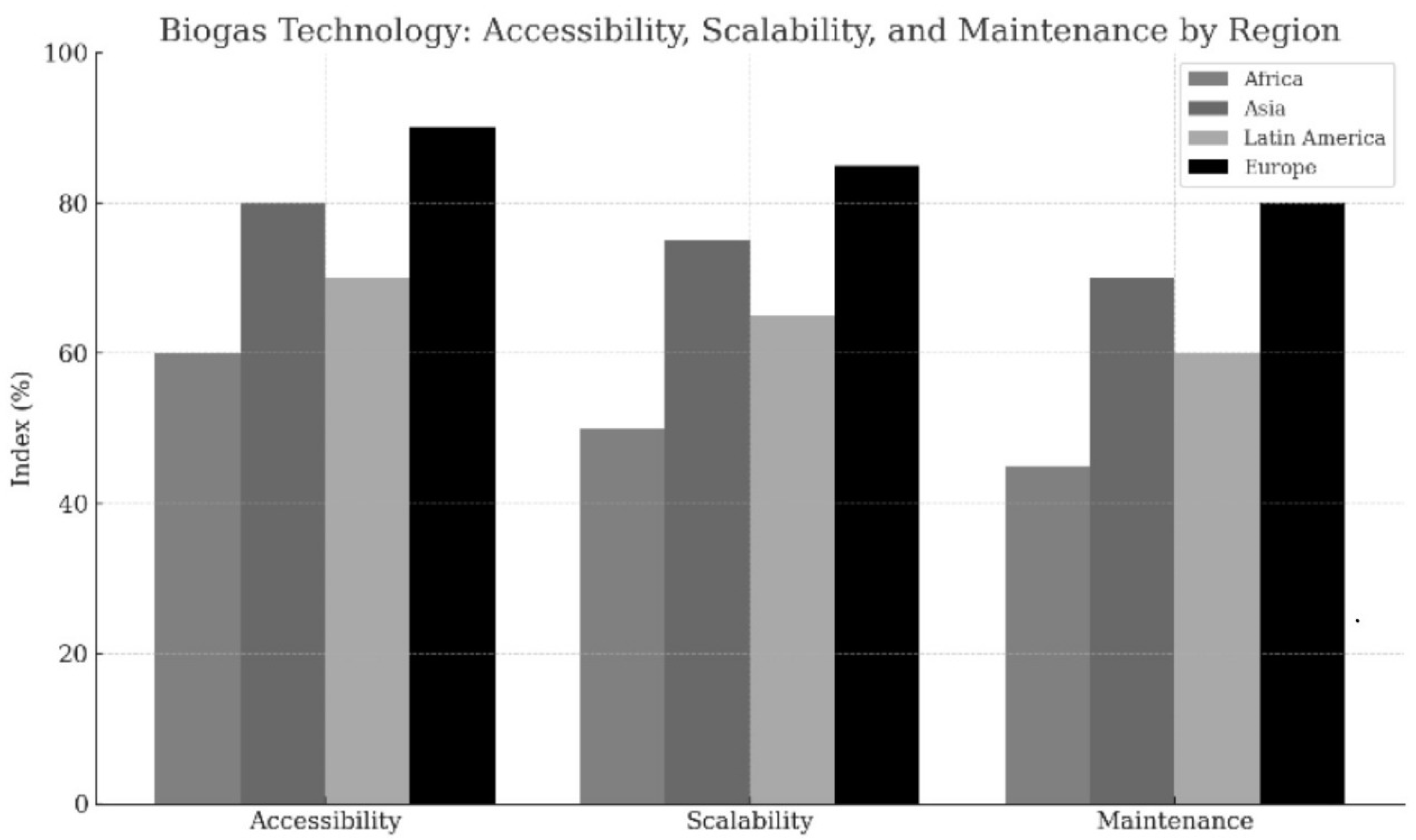
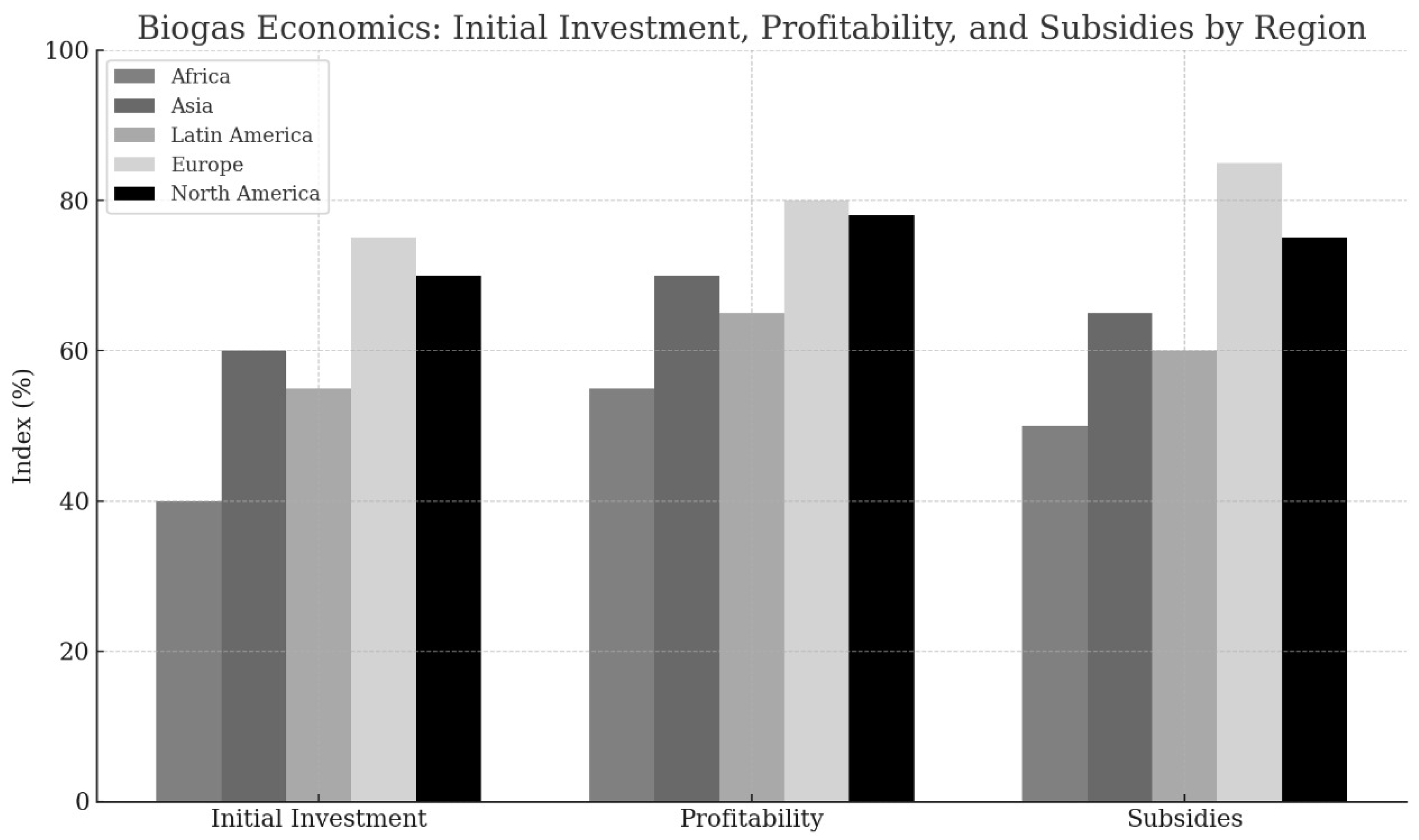
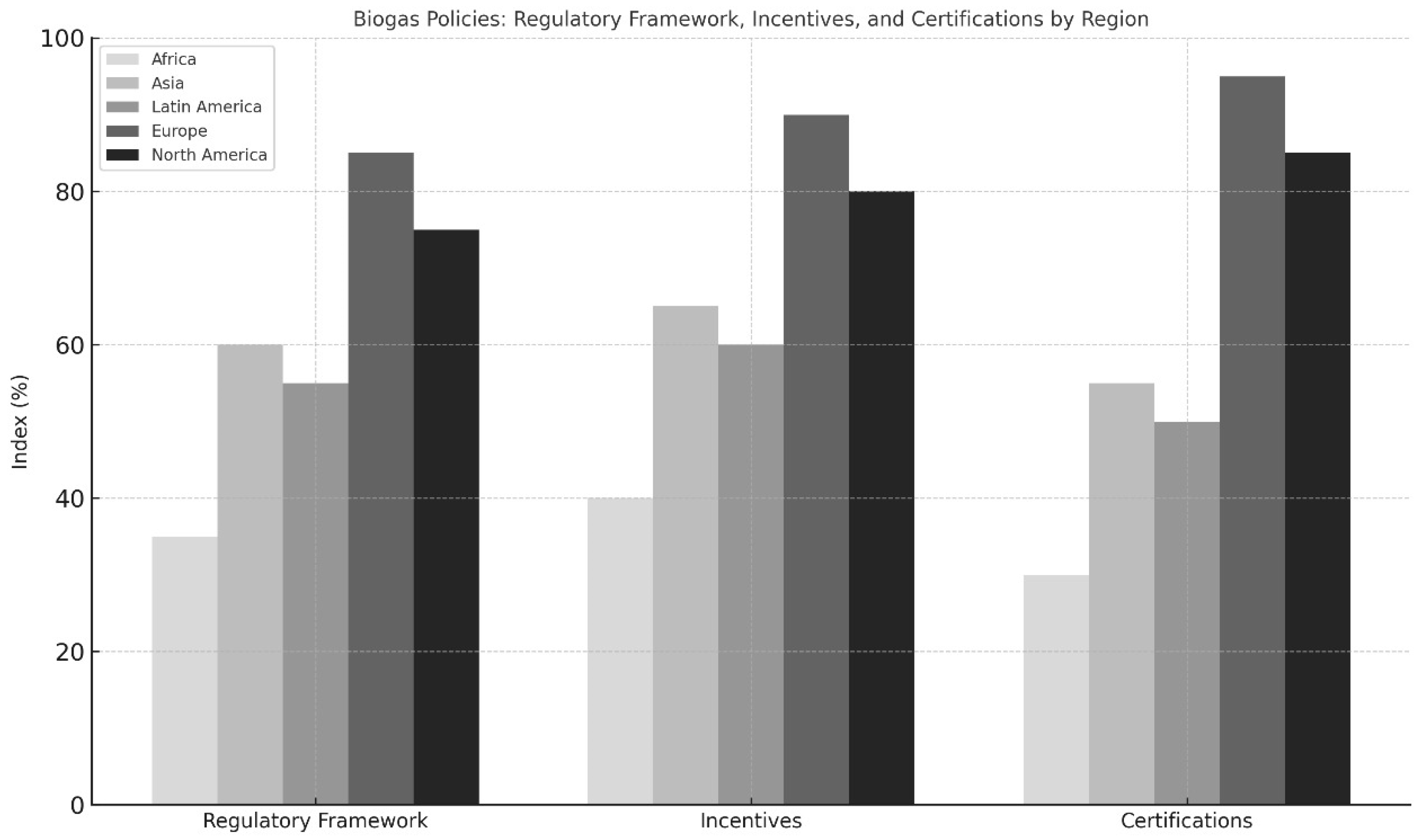
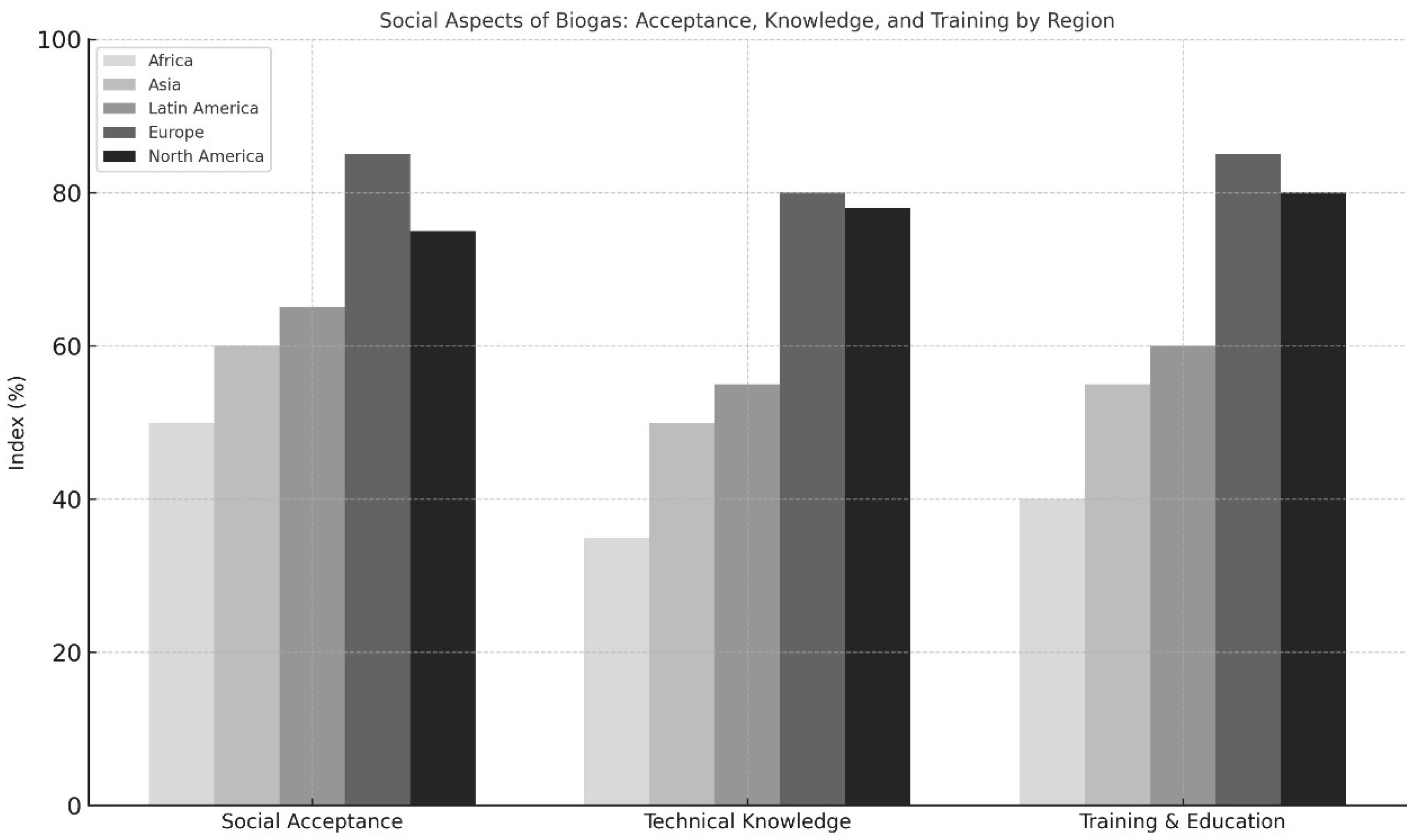
| Region/Country | Agricultural Global [68,69,70] | Ethiopia [71] | United States [70] | EU [69,70,71,72] | Germany (NRW) [73] | Brazil [70] | Mexico [74,75,76] |
|---|---|---|---|---|---|---|---|
| Waste type | Crop residues | Corn/sorghum residues | Forest waste | Mixed waste | Cereal residues | Cane bagasse | Mixed waste |
| Energy potential | 64–161 EJ/year (2050) | 559–1144 PJ/year | 41 M tons/year ≈ 3.2 B gallons of oil | 30–50 EJ/year (2030) | 15–25 PJ/year | 18–22 EJ/year | 1030–3569 PJ/year |
| Current contribution | <5% of the exploited potential | Local use in rural areas | 15–20% used in bioenergy | 10–15% in advanced biofuels | Used in rural heating and electricity | 70% used in cogeneration | <5% used |
| Environmental advantages | Reduces CO2 by 40% vs. open burning Prevents 89% of particulate matter (PM10) emissions | Mitigates in situ burning (pollution) Improves soil management | Reduces fire risk Biochar improves water and nutrient retention | Closed-loop carbon neutrality Reduces dependence on fossil fuels | Maintaining organic matter in soils Reducing synthetic fertilizers | Replaces diesel in machinery Reduces pre-harvest burning | Mitigates 110 Mt CO2 annually (2030) Reduces water/air pollution |
| Main challenges | Competition with food uses Loss of organic carbon in soils | Limited infrastructure Lack of efficient logistics chains | Transportation costs Low profitability in remote areas | Sustainability certification Competition with other industrial uses | Immature markets Requires adjustments to crop rotation | Intensive monoculture Pressure on water resources | Lack of logistical infrastructure Competition with traditional agricultural uses |
| Key technologies | Biorefineries, gasification, pyrolysis | Anaerobic digestion, gasification | Fast pyrolysis, roasting | Hydrotreating (HVO), lignocellulosic fermentation | Biochar, optimized harvesting systems | Combustion in boilers, 2G bioethanol | Gasification, anaerobic digestion, combustion |
| Featured cases | Projects in the EU and the United States for cellulosic ethanol and HVO | National bioenergy plan with a focus on regions such as Oromia (45% of potential) | Projects in California for conversion to biochar and electricity | SAF production in refineries, such as EcoCeres (1000 tons/day) | Integrated projects with cover crops to balance carbon | Integrated plants in São Paulo for bioelectricity | Sugar mill projects for cogeneration |
| Region | Country | Biogas Yields (Approx.) | Policy for Biogas Production | Economic Factors Influencing Biogas Production, Trade, or Frequent Applications |
|---|---|---|---|---|
| Africa [63,90,91,92,93,94,95,96] | South Africa | 18 million m3 per year | The African Biogas Partnership Program (ABPP), supported by the Netherlands Development Organization (SNV), is actually helping to push biogas development in Uganda, Kenya, Tanzania, Ethiopia, and Burkina Faso through the lens of quality standards, performance-based financing, public awareness, and policy advocacy. | Elevated loan interest rates reduce the financial feasibility of biogas projects; central bank interest rates range from 14% to 17%; the cost of installing conventional biogas systems. |
| Nigeria | 6.8 million m3 per day | |||
| Asia [97] | China | 13,480 million m3 per year | The 14th Five-Year Plan for the Modern Energy System, National Energy Administration, 2022; Demonstration Counties for Rural Energy Revolution, 2023; Administrative Measures for Voluntary Emissions Reduction Trading of Greenhouse Gases, 2023. | Biogas-based electricity production, the use of biomethane as fuel for vehicles or industry, injection of biomethane into the gas network, and conversion of biogas into hydrogen or synthetic methane. |
| Latin America [63,97] | Santiago de Chile | 24 million m3 per year | Some of the Brazilian laws and policies are the Distributed Generation of Electricity Law 14.300/2022; the Biomethane Production Law 14.134/2021 or the New Law of Gas; the National Biofuels Law—Federal Law 13.576/2017 or RenovaBio; and At COP 26 (2022). | Using biodigesters helps alleviate poverty; lowers the costs for fuel, organic fertilizers, and food; enhances household sanitation; and supports environmental sustainability. In Brazil, most biogas is converted into electricity. |
| Brazil | 2.3 billion m3 per day | |||
| Europe [97] | Germany | 87,110 (GWh/year) | Germany introduced a coal phase-out program in 2018, targeting a complete exit by 2038, followed by a climate policy package in 2019. A key measure driving the country’s energy transition is the Renewable Energy Sources Act (EEG), the federal government directive to formulate the National Biogas Strategy (NABIS). | It is used more in electricity and fuel for cars. |
| United Kingdom | 32,000 (GWh/year) | The policies in the United Kingdom are related to anaerobic digestion: pollution control grants, the Renewables Obligation Scheme, feed-in tariffs (FiTs), and renewable heat incentives (RHIs). Some other policies related to the biogas sector are the Green Gas Support Scheme (GGSS), the Renewable Transport Fuel Obligation (RTFO), and separate food waste collection. | To generate electricity, heat, and biomethane production. | |
| North America [63,97,98] | United States | 18,500 million m3 per year | Key policy tools in the United States include a mix of federal and state initiatives, such as the Renewable Fuel Standard (RFS), the Inflation Reduction Act (IRA), and various state-level renewable portfolio standards (RPS). | The majority of biogas in the United States and Canada is used in electricity-only plants, with some also used in combined heat and power (CHP) systems. |
| Canada | 22 Pj per year | Support for anaerobic digestion at the federal level in Canada is minimal—the Agricultural Clean Technology Program and feed-in-tariff programs. |
| Phase | Key Actions | Actors Involved | Expected Results |
|---|---|---|---|
| Phase 1: diagnosis and planning [77,78,81,89,90] | Assessment of available waste, identification of local stakeholders, regulatory and financial diagnosis | Local governments, universities, NGOs | Map of opportunities for biogas |
| Phase 2: technological development and pilot [81,82,83] | Installation of pilot biodigesters, technical and socioeconomic validation, initial training | R&D centers, rural communities, private sector | Replicable models adjusted to the local context |
| Phase 3: scaling and financing [78,80,81,86] | Regional expansion of successful systems, access to financing, subsidies and tax incentives | Financial institutions, national governments, cooperation agencies | Increase in rural energy coverage |
| Phase 4: integration into public policies [10,82,84,88,89] | Inclusion of biogas in national climate and energy plans, development of robust regulatory frameworks | Ministries of Energy and Environment | Consolidation of biogas as a pillar of the energy transition |
| Phase 5: monitoring and continuous improvement [78,80,81,86] | Impact assessment, technology upgrade, community strengthening | Civil society, academia, governments | Sustainable systems with high climatic and social impact |
Disclaimer/Publisher’s Note: The statements, opinions and data contained in all publications are solely those of the individual author(s) and contributor(s) and not of MDPI and/or the editor(s). MDPI and/or the editor(s) disclaim responsibility for any injury to people or property resulting from any ideas, methods, instructions or products referred to in the content. |
© 2025 by the authors. Licensee MDPI, Basel, Switzerland. This article is an open access article distributed under the terms and conditions of the Creative Commons Attribution (CC BY) license (https://creativecommons.org/licenses/by/4.0/).
Share and Cite
Uranga-Valencia, L.P.; Pérez-Álvarez, S.; Gabriel-Parra, R.; Chávez-Medina, J.A.; Magallanes-Tapia, M.A.; Sánchez-Chávez, E.; Muñoz-Márquez, E.; García-García, S.A.; Rascón-Solano, J.; Castruita-Esparza, L.U. Biogas Production from Organic Waste in the Forestry and Agricultural Context: Challenges and Solutions for a Sustainable Future. Energies 2025, 18, 3174. https://doi.org/10.3390/en18123174
Uranga-Valencia LP, Pérez-Álvarez S, Gabriel-Parra R, Chávez-Medina JA, Magallanes-Tapia MA, Sánchez-Chávez E, Muñoz-Márquez E, García-García SA, Rascón-Solano J, Castruita-Esparza LU. Biogas Production from Organic Waste in the Forestry and Agricultural Context: Challenges and Solutions for a Sustainable Future. Energies. 2025; 18(12):3174. https://doi.org/10.3390/en18123174
Chicago/Turabian StyleUranga-Valencia, Luisa Patricia, Sandra Pérez-Álvarez, Rosalío Gabriel-Parra, Jesús Alicia Chávez-Medina, Marco Antonio Magallanes-Tapia, Esteban Sánchez-Chávez, Ezequiel Muñoz-Márquez, Samuel Alberto García-García, Joel Rascón-Solano, and Luis Ubaldo Castruita-Esparza. 2025. "Biogas Production from Organic Waste in the Forestry and Agricultural Context: Challenges and Solutions for a Sustainable Future" Energies 18, no. 12: 3174. https://doi.org/10.3390/en18123174
APA StyleUranga-Valencia, L. P., Pérez-Álvarez, S., Gabriel-Parra, R., Chávez-Medina, J. A., Magallanes-Tapia, M. A., Sánchez-Chávez, E., Muñoz-Márquez, E., García-García, S. A., Rascón-Solano, J., & Castruita-Esparza, L. U. (2025). Biogas Production from Organic Waste in the Forestry and Agricultural Context: Challenges and Solutions for a Sustainable Future. Energies, 18(12), 3174. https://doi.org/10.3390/en18123174








